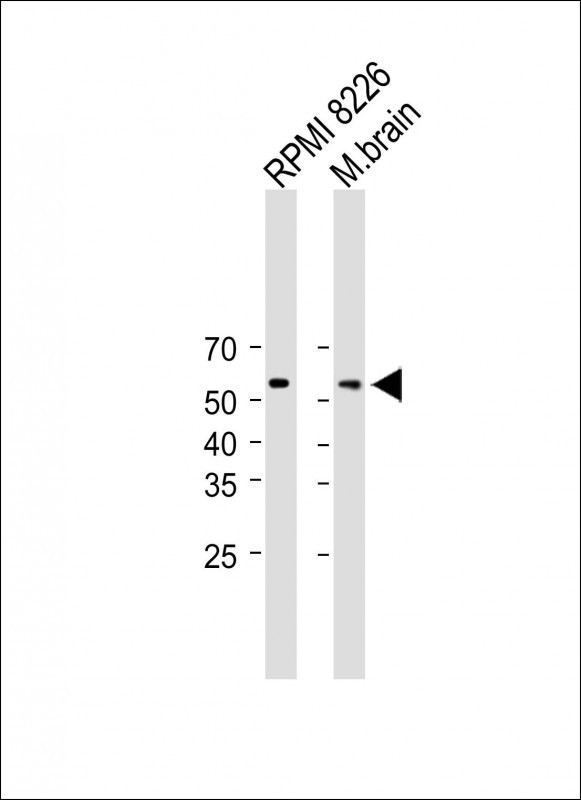SMPD3 Antibody (N-term)
Affinity Purified Rabbit Polyclonal Antibody (Pab)
- 产品详情
- 实验流程
- 背景知识
Application
| WB, E |
|---|---|
| Primary Accession | Q9NY59 |
| Other Accession | O35049, Q9JJY3, NP_061137.1 |
| Reactivity | Human |
| Predicted | Mouse, Rat |
| Host | Rabbit |
| Clonality | Polyclonal |
| Isotype | Rabbit IgG |
| Calculated MW | 71081 Da |
| Antigen Region | 137-165 aa |
| Gene ID | 55512 |
|---|---|
| Other Names | Sphingomyelin phosphodiesterase 3, Neutral sphingomyelinase 2, nSMase-2, nSMase2, Neutral sphingomyelinase II, SMPD3 |
| Target/Specificity | This SMPD3 antibody is generated from rabbits immunized with a KLH conjugated synthetic peptide between 137-165 amino acids from the N-terminal region of human SMPD3. |
| Dilution | WB~~1:1000 E~~Use at an assay dependent concentration. |
| Format | Purified polyclonal antibody supplied in PBS with 0.05% (V/V) Proclin 300. This antibody is prepared by Saturated Ammonium Sulfate (SAS) precipitation followed by dialysis against PBS. |
| Storage | Maintain refrigerated at 2-8°C for up to 2 weeks. For long term storage store at -20°C in small aliquots to prevent freeze-thaw cycles. |
| Precautions | SMPD3 Antibody (N-term) is for research use only and not for use in diagnostic or therapeutic procedures. |
| Name | SMPD3 (HGNC:14240) |
|---|---|
| Function | Catalyzes the hydrolysis of sphingomyelin to form ceramide and phosphocholine. Ceramide mediates numerous cellular functions, such as apoptosis and growth arrest, and is capable of regulating these 2 cellular events independently. Also hydrolyzes sphingosylphosphocholine. Regulates the cell cycle by acting as a growth suppressor in confluent cells. Probably acts as a regulator of postnatal development and participates in bone and dentin mineralization (PubMed:10823942, PubMed:14741383, PubMed:15051724). Binds to anionic phospholipids (APLs) such as phosphatidylserine (PS) and phosphatidic acid (PA) that modulate enzymatic activity and subcellular location. May be involved in IL-1-beta-induced JNK activation in hepatocytes (By similarity). May act as a mediator in transcriptional regulation of NOS2/iNOS via the NF-kappa-B activation under inflammatory conditions (By similarity). |
| Cellular Location | Golgi apparatus membrane; Lipid-anchor. Cell membrane; Lipid-anchor. Note=May localize to detergent-resistant subdomains of Golgi membranes of hypothalamic neurosecretory neurons (PubMed:10823942). Localizes to plasma membrane in confluent contact- inhaibited cells (PubMed:15051724) |
| Tissue Location | Predominantly expressed in brain. |
For Research Use Only. Not For Use In Diagnostic Procedures.
Provided below are standard protocols that you may find useful for product applications.
BACKGROUND
SMPD3 catalyzes the hydrolysis of sphingomyelin to form ceramide and phosphocholine. Ceramide mediates numerous cellular functions, such as apoptosis and growth arrest, and is capable of regulating these 2 cellular events independently. Also hydrolyzes sphingosylphosphocholine. Regulates the cell cycle by acting as a growth suppressor in confluent cells. Probably acts as a regulator of postnatal development and participates in bone and dentin mineralization.
REFERENCES
Bailey, S.D., et al. Diabetes Care 33(10):2250-2253(2010)
Filosto, S., et al. J. Biol. Chem. 285(14):10213-10222(2010)
Maupas-Schwalm, F., et al. Cell. Signal. 21(12):1925-1934(2009)
Talmud, P.J., et al. Am. J. Hum. Genet. 85(5):628-642(2009)
Ito, H., et al. Biochim. Biophys. Acta 1789 (11-12), 681-690 (2009) :
终于等到您。ABCEPTA(百远生物)抗体产品。
点击下方“我要评价 ”按钮提交您的反馈信息,您的反馈和评价是我们最宝贵的财富之一,
我们将在1-3个工作日内处理您的反馈信息。
如有疑问,联系:0512-88856768 tech-china@abcepta.com.























 癌症的基本特征包括细胞增殖、血管生成、迁移、凋亡逃避机制和细胞永生等。找到癌症发生过程中这些通路的关键标记物和对应的抗体用于检测至关重要。
癌症的基本特征包括细胞增殖、血管生成、迁移、凋亡逃避机制和细胞永生等。找到癌症发生过程中这些通路的关键标记物和对应的抗体用于检测至关重要。 为您推荐一个泛素化位点预测神器——泛素化分析工具,可以为您的蛋白的泛素化位点作出预测和评分。
为您推荐一个泛素化位点预测神器——泛素化分析工具,可以为您的蛋白的泛素化位点作出预测和评分。 细胞自噬受体图形绘图工具为你的蛋白的细胞受体结合位点作出预测和评分,识别结合到自噬通路中的蛋白是非常重要的,便于让我们理解自噬在正常生理、病理过程中的作用,如发育、细胞分化、神经退化性疾病、压力条件下、感染和癌症。
细胞自噬受体图形绘图工具为你的蛋白的细胞受体结合位点作出预测和评分,识别结合到自噬通路中的蛋白是非常重要的,便于让我们理解自噬在正常生理、病理过程中的作用,如发育、细胞分化、神经退化性疾病、压力条件下、感染和癌症。






